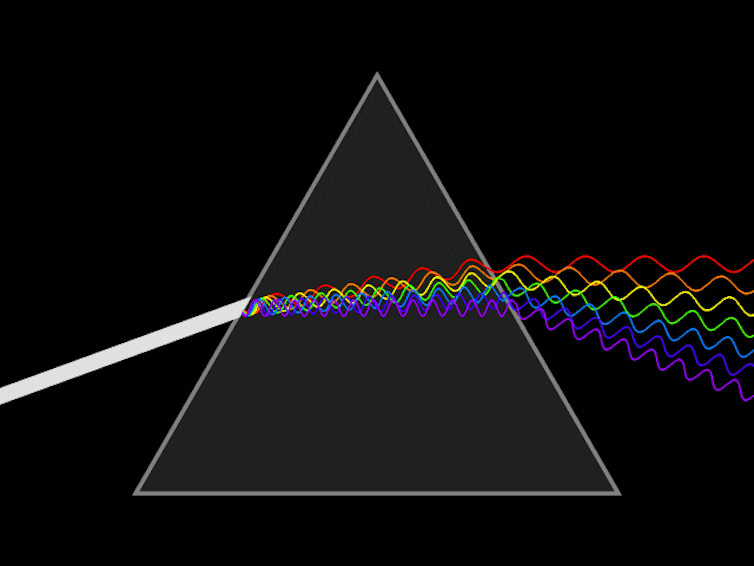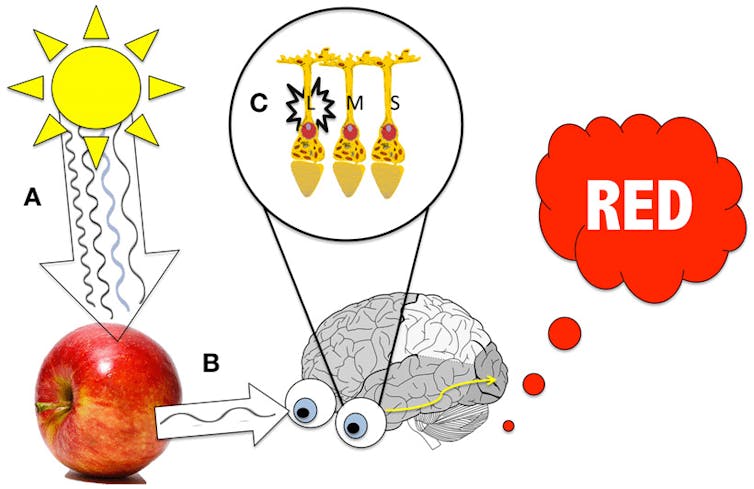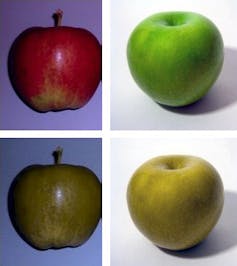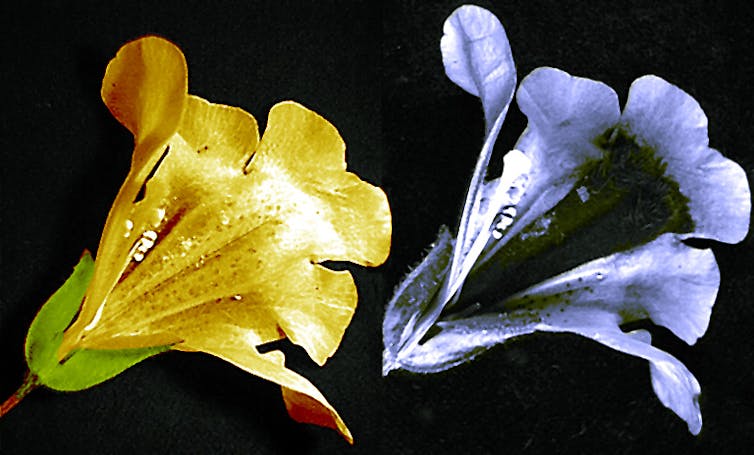Can You See Different Shades Of Color
Curious Kids is a series for children of all ages, where The Chat asks experts to reply questions from kids. All questions are welcome: observe out how to enter at the bottom of this article.
How tin can we be sure that people see the same colour when they wait at something? – Henrietta, historic period 12, Market Harborough, UK
Thanks Henrietta, your question is a skilful one, and in fact we can't be so sure that we practice all run into the same colours. What colours nosotros meet depends not just on how things are in the earth around us, but too on what happens in our eyes and our brains.
If you and I wait at the leaves of a tree, we might both say that they are "greenish". Just could it be that y'all see them as dark-green, while I see them every bit a colour closer to your brown, or possibly even your royal.
Let me explain. The eyes sense lite, and we tin think of light equally beingness made up of many waves of different lengths. The shortest wavelengths nosotros can come across give us the colour violet, while the longest wavelengths give usa scarlet.
There are also lots of wavelengths we can't see, which create colours we tin't even imagine.

Most of the objects we can encounter around united states of america don't make light themselves. Instead, calorie-free from the sun, the moon or man-fabricated lamps hits them.
Depending on the object, some wavelengths of calorie-free volition bounce off, while others volition exist taken in. When we look at an object, our eyes sense the waves of low-cal that have bounced off it.
This all happens very fast, because light moves extremely quickly – most 300m metres per second, in fact.
You might call back that if the colour of an object is decided past the wavelength of lite that bounces off information technology, everyone would come across colours the aforementioned. But in that location's more going on inside the human being body, which affects how people encounter colour.
Cells and cones
The backs of our optics are covered with a thin layer of cells, which respond to light. Cells are the building blocks of all life. The cells in the back of our optics, which assist united states of america to meet colour, are chosen cones.
About people have three kinds of cones in their optics – S, M and 50 cones – and each of these only senses light waves of a sure length.
When a long wave hits an Fifty cone, it seems to fit into it, like a key in a lock. The cone then shouts out to its neighbours that it has caught some light, so we say that it's active.

The L cones just care about long low-cal waves, so they won't grab any short or medium ones: those become to the Due south and K cones.
When calorie-free hits the Due south cones and they go active, nosotros call that "bluish"; when it's the One thousand cones, we run across "green"; and when it's the 50 cones, we see "crimson".
Some people accept more than or fewer than 3 kinds of cone cells in their eyes. Some people – we can't be sure exactly how many – have four kinds of cones. But for those of us with three, we can't really imagine how they might encounter the globe.

Many people merely have ii kinds of cones – these people are often chosen "colourblind". Colourblind people don't see things in blackness and white; they but have trouble telling the difference between cerise and green – both could await sort of brown to them. Dogs besides only have two kinds of cones, so they probably also take trouble seeing differences betwixt carmine and light-green. Merely some animals take amazing colour vision.
For example, bees can see shorter wavelengths than humans, and utilise this ability to find the sweet nectar in flowers. The Mimulus bloom petals take a dark-coloured "path" to guide bees down to the nectar, which humans cannot see at all.

Seeing with your brain
Just it'southward not but our eyes that see – it's our brains. We say we see different colours because of how our brains larn to link the signals they get from the eyes with the names of different colours. When a baby points at a brawl and her begetter asks, "would y'all like to play with that green brawl?", she learns to associate the colour she'due south seeing with the discussion "green", and she will presently phone call things of a similar colour "green" too.
Many other things tin touch on how your brain sees color, including the season, what you looked at before or the position of your torso. Try this experiment to see for yourself:
Prevarication down on your left side for five minutes, with your eyes shut. At present, close your left eye and open up your right eye. Then switch eyes. Do things look different when you're using unlike eyes?
When you laid on your side, more claret went to the lower (left) part of your caput and torso, and this makes the colours you encounter with each middle await different.
Tin we be sure that people see the aforementioned colour when they look at something? Not at all - while the cones in our optics suggest we're seeing something similar information technology's likely that we all run across but a tiny bit differently.
How-do-you-do, curious kids! Have you got a question you lot'd like an skillful to answer? Ask an adult to send your question to us. You tin can:
* Email your question to curiouskids@theconversation.com
* Tell us on Twitter past tagging @ConversationUK with the hashtag #curiouskids, or
* Bulletin united states of america on Facebook.

Please tell us your proper noun, age and which boondocks or city you lot alive in. You tin ship an audio recording of your question also, if you want. Send as many questions equally y'all similar! We won't be able to answer every question, but we will practise our best.
More Curious Kids articles, written past academic experts:
-
What would happen if the Earth's core went common cold? – Amelia, age 13, Devon, U.k.
-
What existed earlier the Big Blindside? – Ethan, historic period ten, Sydney, Australia
-
What is a species? – Finlay, historic period 4, London, Uk
Can You See Different Shades Of Color,
Source: https://theconversation.com/curious-kids-do-different-people-see-the-same-colours-107972
Posted by: graycoses1993.blogspot.com


0 Response to "Can You See Different Shades Of Color"
Post a Comment